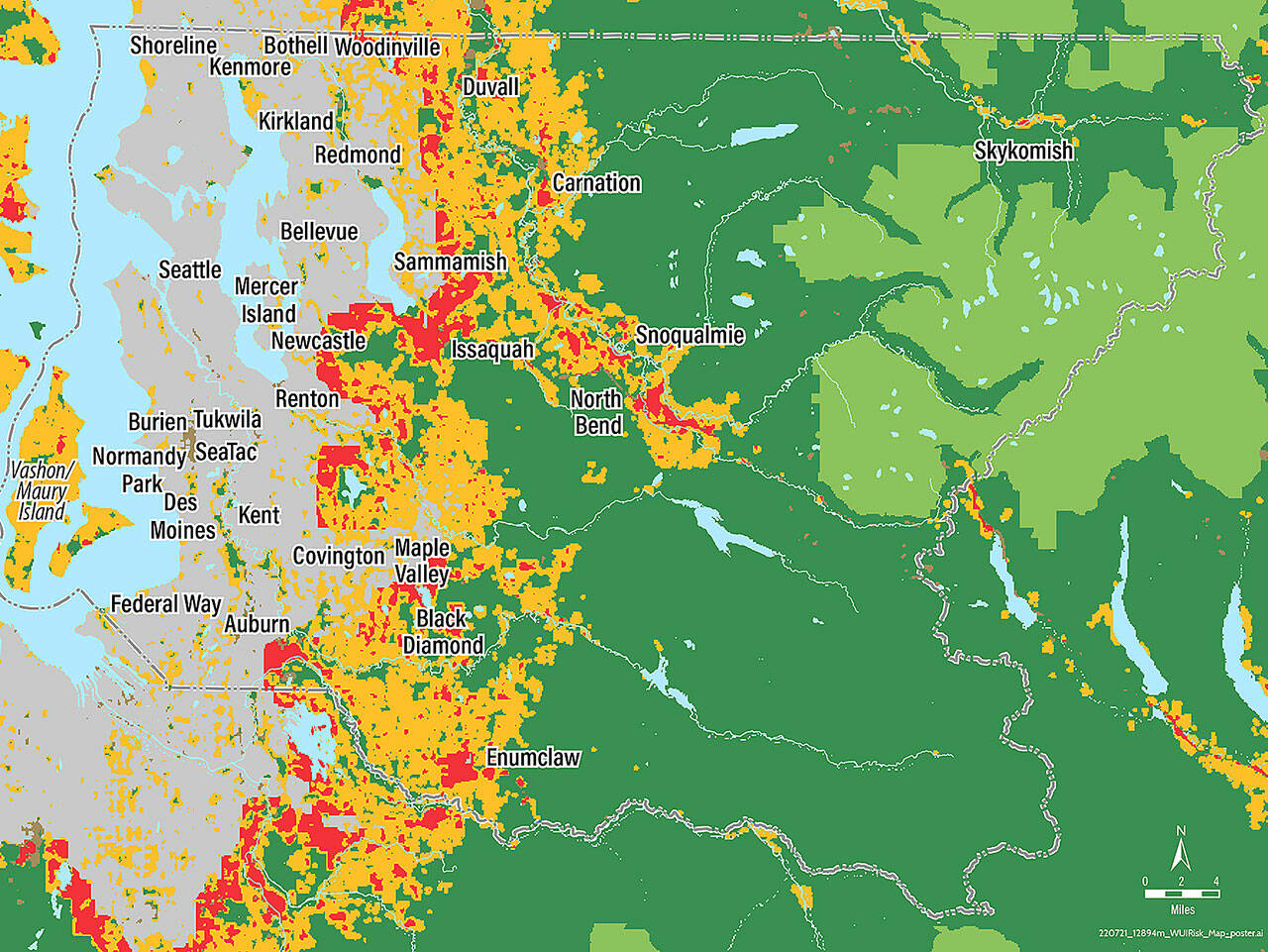Communities in King County, including Vashon, will need a blend of strategies to face growing wildfire risks over the coming decades, according to a wildfire strategy report recently completed by King County.
That’s the big takeaway from the region’s first Wildfire Risk Reduction Strategy, a blueprint for managing and deterring wildfire risk as climate change leads to more extreme weather events.
King County Executive Dow Constantine announced the report July 26.
It focuses primarily on parts of the county called “wildland-urban interfaces” (WUI) — in other words, places where people and infrastructure intermingle with or live right on the edge of the woods and wilderness.
A map, included with the report, shows Vashon and Maury Island included with other communities in the county that meet the criteria of WUI, including Enumclaw Plateau, Issaquah and the Snoqualmie Valley.
In an email exchange, Vashon Island Fire District (VIFR) Chief Matt Vinci, detailed his initial response to the report, saying the district would deliver additional online and in-person WUI training to VIFR staff.
He said the fire district is already well equipped to handle brushfires, with two specialized pieces of fire apparatus equipped to respond, and several pieces of apparatus to shuttle large quantities of water to remote scenes.
“But while we have these resources in place, they are depleted very quickly in a large-scale event and would require off-island resources to be dispatched to support VIFR efforts to contain and extinguish a lager wildfire event,” he said.
Regarding district staffing, Vinci said VIFR will soon be undergoing an agency evaluation and strategic planning process to evaluate its current staffing against national standards, and determine future needs in order to provide effective emergency services.
VIFR routinely experiences challenges, he said, with being able to provide enough resources on-island to respond to simultaneous calls for emergency medical services, and the deployment of adequate resources for fires, rescues, or all-hazards scenarios.
The county report, he added, “gives VIFR and King County an opportunity to engage our partners, double our efforts to educate the public, reduce risk and ensure that we have adequate resources in place to effectively address the wildfire threat on Vashon and in our region.”
Around 15% of King County residents live in the wildland-urban interface, according to the county.
And among the greatest risks of living against the woods and hills is wildfires — 85 percent of which in Washington are caused by people, according to the state Department of Natural Resources.
“The potential for (very large, fast-moving) fires, while still low in any given year, is expected to increase as we experience hotter, drier summers,” the report reads.
King County had around 37 “very high” fire danger days each year, on average, from the 1970s through the 1990s. From 2010 to 2039, the county is shaping up to have about 45 per year, and is projected to have roughly 54 “very high” fire danger days by 2050 or so.
Annual “Extreme” fire danger days, similarly, are projected to rise from only about 11 per year in the late 20th century to about 24 per year by 2050.
Generally, the forests near the eastern part of the county and Vashon-Maury Islands are the focus of the wildfire report.
Many parts of the Enumclaw Plateau expose residents to these wildland-urban interfaces, as do areas in the northeast county such as Issaquah, Snoqualmie and North Bend, as well as cities such as Auburn and Renton.
The strategy basically functions as a five-year plan, active through 2027. King County will take the lead on tracking and evaluating how it plays out.
The actions fall into three buckets: Making forests wildfire resilient, reducing risk in wildland-urban interfaces, and improving emergency response.
The plan calls for promoting more ecological diversity in county forests, giving technical and financial support to small forest landowners to reduce fire risk, improving community education and response plans for wildfires, control flammable invasive plants that lend to wildfire risk and do more countywide training for fire response agencies.
Large-scale controlled burns are less effective in Western Washington, according to the report, because vegetation recovers quickly here and because the burns could permanently change the nature of our dense, ecologically rich woods.
Reducing invasive, flammable plants and controlling fuels such as timber near homes and infrastructure would serve as a better, more precise approach to reducing fire risk, according to the report.
For Vinci, on Vashon, the report will play a part in helping VIFR determine its needs for resources going forward.
“We need to ensure our resources align with the potential risks to our community,” he said.
Read the Wildfire Risk Reduction Strategy at tinyurl.com/4bprv5mb.
Sign up for regional safety alerts at king county.gov/alert and local safety alerts from Voice of Vashon, VashonBePrepared and Vashon Emergency Operations Center at tinyurl.com/5dcbacuk.
— Elizabeth Shepherd contributed local reporting to this article.


